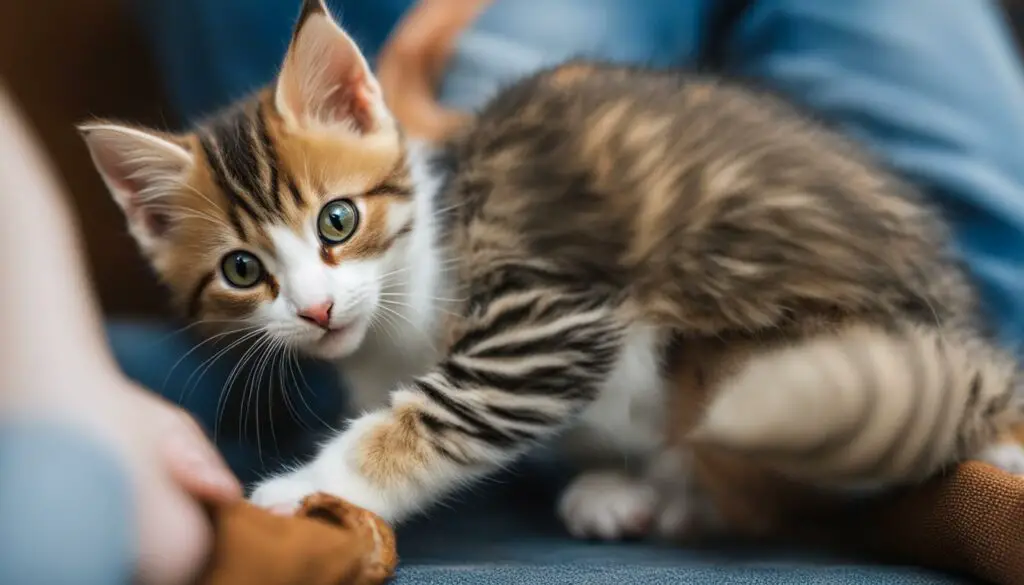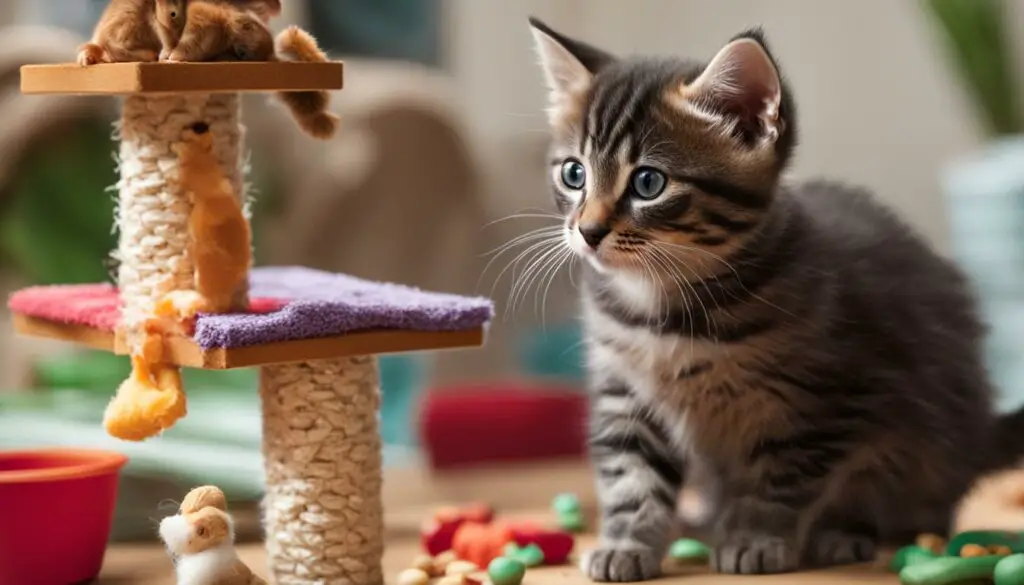Are you tired of your adorable furry friend using your legs as their personal climbing tree? Fret not, as I have some expert guidance and valuable tips to help you prevent this behavior and maintain a scratch-free relationship with your kitten.
Key Takeaways:
- Training kittens not to climb requires patience and consistency.
- Redirecting their climbing behavior to appropriate surfaces, like a scratching post, helps deter leg climbing.
- Positive reinforcement is crucial for teaching kittens the desired behavior.
- Creating a safe environment and providing alternatives to leg climbing will support your efforts.
- Bonding with your kitten through play and redirecting their energy will strengthen your relationship.
Why Do Kittens Like to Climb Up People’s Legs?
Kittens have a natural instinct to climb, and sometimes this behavior extends to climbing up people’s legs. There are several reasons why kittens engage in this leg-climbing behavior. One reason is that kittens may associate legs with trees. In their natural environment, trees provide a safe and elevated vantage point for observation and hunting. Kittens may view legs as a substitute for trees and climb them to satisfy their natural climbing instincts.
Another reason why kittens climb up legs is that they may see legs as giant cat toys. Kittens are playful creatures, and legs can resemble moving objects that pique their curiosity. They may see legs as something fun to climb and play with.
Additionally, kittens may climb legs in search of food. If kittens have been fed or played with while on someone’s legs in the past, they may associate climbing legs with receiving attention, treats, or meals. This positive reinforcement can reinforce the behavior and lead to them climbing legs more frequently.
Furthermore, it’s important to note that kittens are naturally curious and explore their environment through climbing. Their curiosity drives them to investigate new objects and surroundings, including people’s legs. It’s a way for them to satisfy their innate curiosity and learn about their surroundings.

Understanding the reasons behind a kitten’s leg-climbing behavior is the first step in addressing this issue effectively. By providing appropriate alternatives, redirecting their attention, and creating a safe environment, you can guide your kitten towards more desirable behaviors and encourage a strong bond between you and your furry friend.
How to Prevent Your Kitten from Climbing up Your Legs?
Preventing your kitten from climbing up your legs requires patience and consistent training. Here are some effective ways to discourage this behavior:
- Keep your legs covered: Wear thick jeans or long pants to make it more difficult for your kitten to get a good grip on your legs. This will help minimize scratches and discomfort for both of you.
- Distract your kitten with toys: Provide a variety of engaging toys to redirect their attention and energy. Interactive toys, such as feather wands or puzzle toys, can keep them entertained and help shift their focus away from your legs.
- Use deterrents that smell bad to kittens: Kittens have a strong sense of smell, so using deterrents with scents they dislike can discourage them from climbing up your legs. Citrus-scented sprays or products specifically designed to deter cats can be effective.
- Provide alternative climbing surfaces: Give your kitten a designated scratching post or cat tree where they can climb and scratch to their heart’s content. By providing an alternative to your legs, you can redirect their climbing behavior to a more appropriate place.
Remember, training takes time, and it’s important to be patient with your kitten as they learn the boundaries. Consistency is key, so reinforce positive behavior with praise and rewards, while gently discouraging unwanted climbing. With time and effort, you can teach your kitten to respect your personal space and enjoy a scratch-free bond.

Redirecting your kitten’s climbing behavior
Redirecting your kitten’s climbing behavior is another effective strategy. When you notice your kitten attempting to climb your legs, gently guide them towards their scratching post or a climbing tree. Encourage them to engage with these alternatives by using toys or treats as rewards. By consistently redirecting their attention and providing positive reinforcement, your kitten will begin to associate climbing on appropriate surfaces with positive experiences.
Additionally, it’s important to establish and communicate boundaries with your kitten. Use a firm but gentle tone when discouraging them from climbing up your legs, and provide alternative activities or toys to redirect their energy. Consistency and patience are crucial during this training process, as it may take some time for your kitten to fully understand and adjust their behavior.
Providing alternatives to climbing legs
One effective way to prevent your kitten from climbing up your legs is to provide them with alternative activities and outlets for their natural climbing instincts. Invest in a sturdy cat tree or scratching post that offers various levels and surfaces for climbing. You can also introduce interactive toys such as puzzle feeders or treat-dispensing toys to keep them mentally stimulated and physically engaged.
Additionally, incorporating regular play sessions into your kitten’s daily routine can help burn off excess energy and reduce the likelihood of them seeking out your legs as a climbing surface. Use wand toys or laser pointers to engage their natural hunting instincts and provide a healthy outlet for their playful energy.
| Alternative Climbing Surfaces | Benefits |
|---|---|
| Scratching posts | Allows your kitten to exercise their natural instinct to scratch and climb without targeting your legs. |
| Cat trees | Provides multiple levels and platforms for climbing, allowing your kitten to explore and play in a safe and appropriate way. |
| Climbing shelves or wall-mounted perches | Creates vertical space for your kitten to climb and observe their surroundings, satisfying their natural curiosity. |
Dangers of Letting a Kitten Climb Up Your Leg
Allowing a kitten to climb up your leg may seem harmless, but it can actually pose several risks and dangers. Here are some of the potential consequences:
- Injuries: When a kitten climbs up your leg, their sharp claws can scratch and puncture your skin. These scratches can be painful and may lead to infections if not properly cleaned and treated.
- Scratches and Bites: During the climbing process, kittens may unintentionally scratch or bite you in their attempt to find support or maintain balance. These injuries can range from minor scratches to deep bites that may require medical attention.
- Damage to Clothing: Kittens’ claws can easily snag and tear delicate fabrics, such as stockings or thin pants. This can lead to costly repairs or the need to replace clothing altogether.
- Potential for Broken Bones: Although rare, there is a possibility of sustaining a broken bone if a kitten climbs too high and accidentally falls onto your leg or if you lose your balance trying to prevent the climb.
It’s important to remember that while kittens may see leg climbing as a playful behavior, it can have serious consequences for both you and them.
To avoid these potential dangers, it is crucial to train your kitten not to climb up your leg and redirect their climbing instincts to appropriate surfaces and toys. By providing alternative outlets for their climbing needs and ensuring a safe environment, you can prevent accidents and maintain a harmonious relationship with your furry friend.
Table: Risks of Allowing a Kitten to Climb Legs
| Risk | Description |
|---|---|
| Injuries | Kittens’ sharp claws can cause scratches and puncture wounds on your skin. |
| Scratches and Bites | Kittens may accidentally scratch or bite you while attempting to climb. |
| Damage to Clothing | Kittens’ claws can snag and tear delicate fabrics, leading to damage or the need for repairs. |
| Potential for Broken Bones | There is a small risk of sustaining a bone fracture if a kitten climbs too high and falls. |

How to Train a Kitten Not to Climb Up Your Leg?
Training a kitten not to climb up your leg requires patience and consistency. By teaching them appropriate behavior and providing alternative outlets for their climbing instincts, you can redirect their behavior and prevent leg climbing. Here are some effective techniques:
- Teach appropriate behavior: Use positive reinforcement to reward your kitten for desired behavior. When they climb on a scratching post or use their cat tree, praise and reward them with treats or affection.
- Provide a cat tree for climbing: A cat tree is a great way to provide your kitten with a safe and appropriate outlet for their climbing instincts. Make sure the cat tree is stable and tall enough to satisfy their climbing needs.
- Redirect their claws: When your kitten starts to climb your leg, gently redirect their claws to a scratching post or a designated scratching pad. This will help them understand where they should be using their claws.
Remember, consistency is key when training your kitten. Be patient and continue to reinforce positive behavior. With time and practice, your kitten will learn to climb in appropriate places and not on your legs.
| Training Techniques | Effectiveness |
|---|---|
| Positive reinforcement | Highly effective |
| Providing a cat tree | Very effective |
| Redirecting claws | Effective with consistency |
By using these training techniques and providing appropriate alternatives for climbing, you can help your kitten develop good behavior and prevent them from climbing up your legs.

Redirecting Playful Energy
Kittens often climb legs out of playfulness and excess energy. It’s important to redirect their energy into appropriate play activities. Use interactive toys, such as feather wands or laser pointers, to engage your kitten in active play sessions. This will help tire them out and provide an outlet for their climbing instincts without resorting to climbing your legs.
Tips for Keeping Your Kitten Safe While They’re Climbing
When your adorable little furball starts climbing, it’s important to ensure their safety. Here are some tips to help you keep your kitten safe while they indulge in their natural climbing instincts:
- Monitor their climbing: Keep a close eye on your kitten while they are climbing to ensure they don’t reach dangerous heights or get stuck in a precarious position. This way, you can intervene if necessary and provide assistance.
- Trim their claws: Regularly trim your kitten’s claws to minimize the risk of accidental scratches while they are climbing. This not only protects you but also prevents them from getting caught on surfaces or objects.
- Use a leash for control: If you’re taking your kitten outdoors for climbing adventures, it’s essential to use a leash to maintain control. This prevents them from wandering off or getting into potentially dangerous situations.
By following these safety measures, you can ensure that your kitten enjoys their climbing activities while minimizing any potential risks or accidents. Remember, a safe and secure environment is crucial for a happy and healthy feline companion!

| Common Risks of Unsupervised Climbing | Preventive Measures |
|---|---|
| Getting stuck in high places | Supervise climbing activities and provide easy access to safe climbing areas. |
| Accidental falls | Ensure sturdy furniture and install safety nets or barriers to prevent falls from heights. |
| Scratching or damaging furniture | Provide designated scratching posts or boards to redirect their climbing and scratching instincts. |
| Getting stuck or injured in tight spaces | Remove or secure small gaps or openings where your kitten may find themselves trapped. |
Remember, while climbing is a natural behavior for kittens, it’s important to strike a balance between allowing them to explore their instincts and ensuring their safety. With proper supervision, maintenance of a kitten-friendly environment, and thoughtful precautions, you can create a safe and enjoyable climbing experience for your furry friend.
Creating a Safe Environment for Your Kitten
When bringing a new kitten into your home, it’s essential to create a safe environment that minimizes potential hazards and promotes their well-being. By taking a few precautions, you can ensure that your furry friend can explore and play without encountering unnecessary risks.
Securing Furniture and Objects
To prevent accidents and injuries, it’s important to secure furniture and objects that may pose a danger to your kitten. Anchor bookshelves, cabinets, and heavy objects to the wall to prevent them from tipping over and causing harm. Use cord holders to secure electrical cords and cables, keeping them out of your kitten’s reach to prevent chewing or accidental entanglement.
Keeping Hazardous Items Out of Reach
Kittens are naturally curious and may try to investigate anything within their reach, so it’s crucial to keep hazardous items out of sight and reach. Store cleaning supplies, medications, and toxic plants in locked cabinets or high shelves. Secure trash cans with lids to prevent access to potentially harmful items. By creating a safe and toxin-free environment, you can protect your kitten from accidental ingestion or exposure to dangerous substances.
Providing Climbing Opportunities
Kittens have a natural instinct to climb, so providing them with appropriate climbing opportunities is important. Invest in a sturdy cat tree or scratching post that allows your kitten to exercise their climbing skills in a safe and controlled manner. This not only satisfies their natural instincts but also helps redirect their attention from climbing on furniture or other potentially fragile items.
Ensuring Closed Windows and Doors
Open windows and unsupervised access to balconies or outdoor areas can put your kitten at risk of falling or escaping. Always ensure that windows are securely closed and screened to prevent any accidental falls. Additionally, keep doors leading to potentially dangerous areas, such as basements or garages, closed to avoid any accidents or escapes.
| Hazard | Safety Precautions |
|---|---|
| Chemicals and Cleaning Products | Store them in locked cabinets or high shelves. |
| Electrical Cords and Cables | Use cord holders and keep them out of your kitten’s reach. |
| Trash Cans | Secure them with lids to prevent access to potentially harmful items. |
| Fragile Items | Store them safely or keep them out of your kitten’s reach. |
Offer Alternatives
When your kitten starts climbing up your legs, it’s important to provide alternative activities to redirect their attention. Distracting them with toys or treats can help shift their focus away from your legs and onto something more appropriate. Consider using interactive toys that engage their natural hunting instincts or treats that require them to work for them.
Positive reinforcement is also a powerful tool in teaching your kitten not to climb. Whenever your kitten chooses an alternative activity instead of climbing your legs, praise them and reward them with positive reinforcement, such as a treat or gentle petting. This encourages them to repeat the desired behavior and reinforces the idea that climbing legs is not a rewarding activity.
Using a Scratching Post
Providing a scratching post is another effective way to deter your kitten from climbing your legs. A scratching post serves as a designated area for your kitten to engage in their natural climbing and scratching behaviors. Place the post in a central location and sprinkle it with catnip to attract your kitten’s interest. Encourage them to use the scratching post by gently guiding their paws and praising them when they scratch the post instead of your legs.
| Benefits of Offering Alternatives | How to Implement |
|---|---|
| Prevents scratches and bites | Have a variety of toys and treats readily available |
| Redirects your kitten’s energy and curiosity | Engage in interactive play sessions with your kitten |
| Strengthens the bond between you and your kitten | Provide positive reinforcement and affection when your kitten chooses an alternative activity |
| Creates a positive and harmonious environment | Be patient and consistent in redirecting their behavior and offering alternatives |
Remember, every kitten is unique, and what works for one may not work for another. Be patient, experiment with different techniques, and observe what captures your kitten’s interest. With time and positive reinforcement, you can train your kitten to abandon climbing legs in favor of more appropriate activities.

Redirect their Attention
When your kitten starts climbing up your legs, it’s important to redirect their attention to more appropriate activities. One effective way to do this is by distracting them with toys or treats. Keep a stash of their favorite toys nearby and offer them as a diversion when you see your kitten getting ready to climb. Engaging them in playtime not only redirects their energy but also reinforces positive behavior.
Another technique to redirect their attention is through interactive play. Using toys that require their active participation, such as puzzle toys or treat-dispensing toys, can keep their focus away from your legs. These toys provide mental stimulation and satisfy your kitten’s natural instinct to explore and hunt. By redirecting their climbing tendencies to these interactive toys, you can encourage more appropriate behavior and minimize leg climbing.
Positive reinforcement is also crucial in redirecting your kitten’s attention. Whenever your kitten chooses not to climb your legs and engages in other activities, praise and reward them with treats or verbal affirmations. This positive reinforcement helps them associate good behavior with rewards and encourages them to choose alternative activities over climbing your legs.
Remember, redirecting your kitten’s attention requires consistency and patience. It may take time for them to learn and break the habit of climbing legs. Reinforce positive alternatives, be consistent with redirection techniques, and provide plenty of toys and interactive activities to keep them engaged. With time and effort, you can successfully redirect their attention and prevent leg climbing behavior.
| Redirecting Kitten’s Attention | Tips and Techniques |
|---|---|
| Toys and Treats | Keep a stash of your kitten’s favorite toys nearby and offer them as a diversion when they start climbing. Engage them in interactive play and use puzzle toys or treat-dispensing toys to keep their focus away from your legs. |
| Positive Reinforcement | Praise and reward your kitten with treats or verbal affirmations whenever they choose not to climb your legs. This positive reinforcement helps them associate good behavior with rewards and encourages them to choose alternative activities. |
| Consistency and Patience | Redirecting your kitten’s attention takes time and consistency. Be patient with them as they learn and reinforce positive alternatives. Provide plenty of toys and interactive activities to keep them engaged and entertained. |
By redirecting your kitten’s attention and providing them with positive alternatives, you can effectively prevent leg climbing. Remember to be patient and consistent in your training efforts, and soon your cuddly companion will learn more appropriate behaviors.
Wear Thicker Jeans
When it comes to preventing your kitten from climbing up your legs, one simple solution is to wear thicker jeans. The thicker fabric provides a deterrent for kittens trying to climb, making it more difficult for them to get a good grip. Not only does this minimize the discomfort of sharp claws on your skin, but it also reduces the risk of scratches and potential injuries.
Thicker jeans act as a physical barrier, creating a barrier between your legs and your kitten’s instinct to climb. This can help redirect their attention to more appropriate surfaces, such as a scratching post or a cat tree. Additionally, wearing thicker jeans can give you peace of mind knowing that your legs are protected during playtime with your energetic feline friend.
| Benefits of Wearing Thicker Jeans |
|---|
| Provides a deterrent for kitten climbing |
| Reduces the risk of scratches and injuries |
| Redirects kitten’s attention to appropriate surfaces |
| Gives you peace of mind during playtime |
So next time you interact with your kitten, try wearing a pair of thicker jeans to discourage them from using your legs as a climbing post. Remember to combine this technique with other preventative measures, such as providing alternative surfaces for climbing and using positive reinforcement to reinforce desired behaviors. With patience and consistency, you can foster a safe and enjoyable environment for both you and your furry companion.

Choosing the Right Jeans
When choosing jeans to wear around your climbing-prone kitten, opt for thicker fabrics such as denim or twill. These materials provide more resistance to your kitten’s claws and are less likely to be easily pierced.
It’s also important to ensure that your jeans fit well. Baggy or loose-fitting jeans may give your kitten more opportunities to climb up your legs, as they can easily latch onto excess fabric. Look for jeans that fit snugly and offer a secure, streamlined silhouette.
Have Fun With Your Kitten!
Building a strong bond with your kitten is not only a wonderful experience but also a great way to prevent leg climbing. Spending quality time playing and interacting with your furry friend can help redirect their energy into play and reduce their desire to climb up your legs.
Playing with your kitten provides them with mental stimulation and physical exercise, which helps keep them content and less likely to engage in unwanted behaviors like leg climbing. Use interactive toys such as feather wands or laser pointers to engage your kitten in active play sessions. This will help redirect their natural instincts onto appropriate surfaces and objects.
It’s also important to provide your kitten with a variety of toys and scratching posts. Kittens have a natural urge to climb and scratch, so having designated areas for these activities will help satisfy their needs. A scratching post can serve as a great alternative to climbing legs, as it allows them to stretch, exercise, and groom their claws. Make sure to choose a scratching post that is sturdy and tall enough for your kitten to fully extend their body while scratching.
Quotes:
“Playing and bonding with your kitten is key to preventing leg climbing.” – Dr. Sarah Johnson, Veterinarian
“Providing toys and scratching posts will help redirect your kitten’s climbing instincts onto appropriate surfaces.” – Emily Parker, Cat Behavior Specialist
| Benefits of Playtime and Bonding | |
|---|---|
| 1. | Reduces stress and anxiety in kittens |
| 2. | Strengthens the bond between you and your kitten |
| 3. | Provides mental and physical stimulation |
| 4. | Helps redirect their energy into positive behaviors |
| 5. | Creates a harmonious and loving relationship |

By focusing on playtime and bonding with your kitten, you can not only prevent leg climbing but also foster a strong and loving relationship. Remember to be patient and consistent in your interactions with your kitten, and don’t forget to shower them with love and affection as you navigate this delightful journey together.
Conclusion
In conclusion, stopping your kitten from climbing up your legs is possible with the right guidance and techniques. By understanding the reasons behind this behavior and implementing the provided tips, you can create a scratch-free and harmonious relationship with your cuddly companion. Remember, consistency, patience, and positive reinforcement are key to training your kitten and redirecting their climbing instincts.
By providing alternatives such as toys, treats, and a scratching post, you can distract your kitten from climbing on your legs and redirect their attention to appropriate surfaces. Wearing thicker jeans can also serve as a deterrent to prevent them from getting a good grip. Additionally, creating a safe environment and monitoring your kitten’s climbing activities will help keep them out of harm’s way.
Building a strong bond with your kitten and offering plenty of playtime is essential to prevent leg climbing. Spend quality time with your furry friend, engage in interactive play, and channel their energy into positive activities. With these strategies in place, you can enjoy a safe and enjoyable relationship with your kitten, free from leg climbing and scratches.
FAQ
Why do kittens like to climb up people’s legs?
Kittens may associate legs with trees, see legs as giant cat toys, climb for food, or simply out of curiosity.
How can I prevent my kitten from climbing up my legs?
You can keep your legs covered, distract your kitten with toys, use deterrents that smell bad to kittens, provide a scratching post as an alternative, and be patient as your kitten learns the boundaries.
What are the dangers of letting a kitten climb up my leg?
Allowing a kitten to climb up your leg can result in them falling and hurting themselves, you getting scratched or bitten, your clothing getting damaged, and in severe cases, even a broken bone.
How can I train my kitten not to climb up my leg?
Training a kitten not to climb up your leg requires consistency and positive reinforcement. Provide a cat tree, use positive reinforcement techniques, and redirect their claws to appropriate surfaces.
How can I keep my kitten safe while they’re climbing?
Monitor their behavior, keep their claws trimmed to prevent accidental scratching, and use a leash for extra control during outdoor climbing adventures.
How can I create a safe environment for my kitten?
Secure furniture and objects to prevent accidents, keep hazardous items out of reach, provide climbing opportunities such as a cat tree, and ensure windows and doors are securely closed.
How can I deter my kitten from climbing up my legs?
Offer alternative activities, distract them with toys or treats, use positive reinforcement to reward desired behavior, and provide a scratching post as an appropriate outlet for their natural climbing instincts.
How can I redirect my kitten’s attention when they try to climb up my legs?
Offer toys or treats as a distraction, consistently provide positive alternatives, and discourage their leg-climbing behavior.
Can wearing thicker jeans prevent my kitten from climbing up my legs?
Yes, thicker fabric can make it more difficult for them to get a good grip and minimize the discomfort and risk of scratches.
How can I have fun with my kitten while preventing leg climbing?
Spend time playing and bonding with them, provide toys and scratching posts, and redirect their climbing instincts onto appropriate surfaces.
Source Links
- https://micatguide.com/how-stop-kitten-climbing-leg/
- https://outdoorcave.com/how-to-stop-a-kitten-from-climbing-up-your-leg/
- https://cats.com/why-does-my-cat-climb-me-like-a-tree








